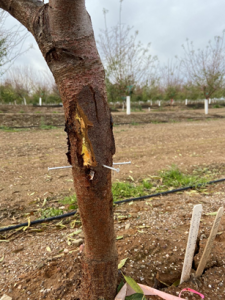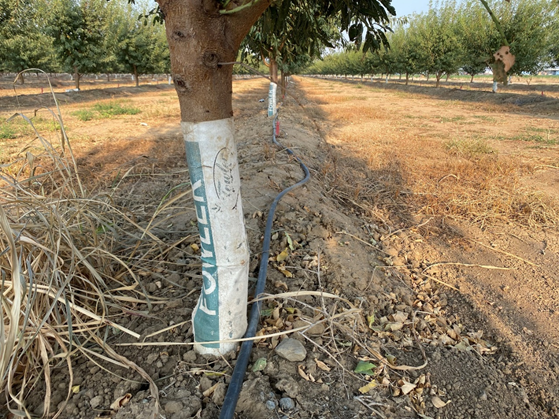Luke Milliron, UCCE Orchard Advisor Butte, Glenn, & Tehama Counties
It can be difficult to know when to replace or remove tree cartons. Being too early (photo 1) or late (photo 2) with carton removal has been the source of numerous farm advisor calls over the years.

Photo 1. Sunken and darkened bark are damage symptoms from Glufosinate (e.g. Rely 280) trunk damage. The inserted nails were used as part of a research trial to determine bark growth. Photo credit: Drew Wolter. Glufosinate damage can also appear as small gum balls on the trunk. More pictures and keys for distinguishing it from Phytophthora, band canker, and bacterial canker: here.
Problems with removing cartons too EARLY: The orchard is a harsh new environment for a potted or bareroot tree from the nursery. The paper carton (aka tree protector, trunk wrap) that comes with the tree from the nursery, along with diluted white latex paint help protect trees from sunburn, and Pacific Flatheaded Borer. However, UCCE research has recently shown that white interior latex paint (diluted 50/50 with water) may provide little, if any, benefit in protecting the truck from herbicide damage. Instead, the physical barrier of the carton is needed to protect young, green bark from self-inflicted herbicide drift damage.
From planting onwards, there are a few key decision/action points for trunk cartons. At planting, cartons provide continuous coverage, are easy to apply and settle with the soil. If the trees are not painted, trunk protecting boxes should be flattened (look like ◊ this from the top, not this □) to avoid “box burn”. Now, some nursery tree carton interiors are black at the top of the carton to help avoid box burn. For more “at planting” considerations see: Sacramento Valley Orchard Source article.
There is the concern that the paper carton will disintegrate before trunks are sufficiently hardened off to be resistant to herbicide injury. There needs to be more research on when you can safely remove cartons and not worry about trunks being damaged by herbicide. Former UCCE advisor David Doll (aka The Almond Doctor) suggests “…keeping them on through the summer of the second year as it provides protection for the late spring burn down while still giving an opportunity to remove them before debris and tree growth makes it more difficult.” In their research showing that paint did not protect trunks former UCCE intern Drew Wolter and advisor Dani Lightle found that nine weeks of hardening off (i.e. time between carton removal and herbicide application to the trunk) significantly reduced herbicide damage. Therefore, there are both orchard age (late in 2nd leaf) and hardening off (maximize time between carton removal and next herbicide application) components to preventing herbicide damage to young almond trunks. Of course, avoid self-inflicted herbicide injury by following best practices, including avoiding spraying near tree trunks when possible, considering a strip spray program without a green bark label warning, and avoiding spraying during windy conditions. More information on herbicide management in young orchards can be found in the article in this newsletter.
Problems with removing cartons too LATE:
Keeping wraps on too long is also asking for problems! You always want open air between the carton and the tree trunk. What you don’t want is water trapped between the carton that’s pressed against the enlarging trunk — that’s asking for a Phytophthora infection, and there are several ways that can happen. Debris like leaf litter may accumulate between the trunk and the carton over time and trap moisture against the trunk/crown of the tree. If you have higher angle sprinkler irrigation or heavy rainfall, mud can seal the bottom of the carton to the soil and the carton will fill with water. It’s a good practice to periodically go through and gently lift each carton a few inches, ensuring that it hasn’t become sealed to the soil surface or had the bottom couple of inches buried by soil and pressed against the trunk – just watch out for wasps when doing this! If the carton is not occasionally lifted from the soil line, there’s a risk that when the carton is removed, the portion of the carton buried below the soil surface remains. Although the paper component of the buried carton quickly disintegrates, the plastic film coating remains and traps water against the crown of the tree. A final practice to avoid is waiting to remove the carton until after the trunk has grown snug to the carton (photo 2). When the carton and trunk are snug, every time the carton gets wet, it keeps the trunk wet for a prolonged period and risks disease infection.

Photo 2. Trunk cartons were left on the trees in this orchard until the trees had grown snug to the carton. Although there were no Phytophthora infections seen in this orchard at the time of the photo (August 30, 2021), the longer the cartons are left on, the higher the risk of problems. Photo: Luke Milliron.
Side note: Carton or no-carton, we want to keep water off tree trunks and crowns! The one exception to this guidance is those roughly 30 days after planting a potted orchard (see article in this newsletter). However, going forward, the best practice for all orchard crops is to keep water OFF the trunks. There are no roots taking up water at the base of the trunk and it’s a high risk for fungal and bacterial canker infections that can severely shorten the life of your orchard. Use emitter location and type as well as sprinkler stream-splitters to keep trunks and tree crowns dry and disease free!


Leave a Reply